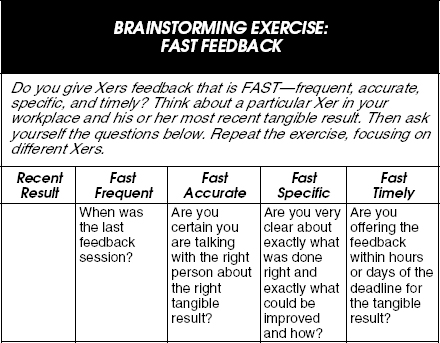9.
Giving Gen-Xers the Fast Feedback They Need
How do we understand Xers’ need for feedback?
Most organizations still rely on six-month and twelve-month reviews as their primary method of performance evaluation. These formal reviews vary a great deal in format and style, but any way you slice it, Generation Xers see very little connection between their work and formal reviews of any kind.
Here is what Xers say about formal reviews:
1. Formal reviews happen so infrequently, they almost never provide feedback that is accurate, specific, and timely.
2. Often, managers and employees use the review process to protect their own interests and, therefore, reviews are usually not as candid as they should be.
3. Reviews often reflect personality issues, rather than performance evaluations.
4. Reviews create unrealistic expectations with respect to raises and promotions.
Xers see their relationships with employers as day-to-day mutual exchanges of added value. Xers invest their time, labor, and creativity. Employers provide regular short-term dividends. But those dividends can’t always be in the form of money. F*A*S*T Feedback™ is one of the short-term dividends most sought by Xers in their pursuit of Self Building career security. Instead of six- and twelve-month performance reviews, give Xers F*A*S*T Feedback™.
F*A*S*T is an acronym = Frequent, Accurate, Specific, and Timely
| Frequent | = | Provide feedback every time Xers complete a tangible result. |
| Accurate | = | Double check yourself before you praise or critique Xers’ work. |
| Specific | = | Focus your evaluation on details and provide guidelines for improvement. |
| Timely | = | Give feedback immediately while your comments still seem relevant. |

SELF-ASSESSMENT QUESTIONNAIRE: CULTURE, CREATIVE PROCESS, AND FEEDBACK
Assess your company’s culture and its practices regarding the creative process and feedback by responding to the questions below.
1. Which statement best captures your company’s workplace philosophy?
A. We celebrate the success of individuals, rewarding hard work, productivity, and creativity.
B. The company is a team, and everyone shares credit and blame equally.
C. We place the greatest value on loyalty and seniority.
2. Which statement best describes the management structure in your company?
A. There are several layers of management between the lowest and the highest.
B. There are few layers of management, and junior people deal directly with senior people.
C. Employees are managed on the same project by several managers at different levels.
3. Which statement best describes the knowledge base of the managers in your company?
A. Managers maintain a close awareness of the work they are managing because they have done it themselves and they remain involved enough to understand the obstacles their employees face.
B. Often managers are managing work they have never actually done themselves.
C. Managers usually manage work they have done themselves at one time, but often the nature of the work has changed since they did it themselves.
4. In your company, how are work teams structured?
A. They are given a clear mission with clear parameters and have one strong leader.
B. They are given a clear mission with clear parameters, but do not have one strong leader.
C. They have a strong leader, but often their mission is fluid and the parameters change.
5. In your company, how are important decisions made?
A. At the top with little input from lower-level people.
B. At the top with input from those employees who will be affected by the decision.
C. Input from all employees is sought and decisions are achieved by consensus.
6. In your company, how are projects generally managed?
A. After goals and deadlines are set, managers help employees throughout the process, requiring them to check in at each stage before moving on.
B. After goals and deadlines are set with clear parameters, managers allow employees the freedom to achieve the goals within the established time frame, but remain available if employees have questions.
C. When goals and deadlines are assigned, parameters are left unclear so that employees are free to use their creative imaginations.
7. How often do you provide some type of feedback to your Gen-X employees?
A. Daily
B. Weekly
C. Monthly or longer
8. How do you provide feedback to Gen-X employees?
A. Formal performance reviews based on prearranged criteria.
B. Informal discussions periodically based on mutually understood but unspoken criteria.
C. Immediately and in detail, based on the strengths and weaknesses of employees’ specific work products.
Review your answers and take a moment to evaluate the current state of your organization with respect to culture, creative process, and feedback.
